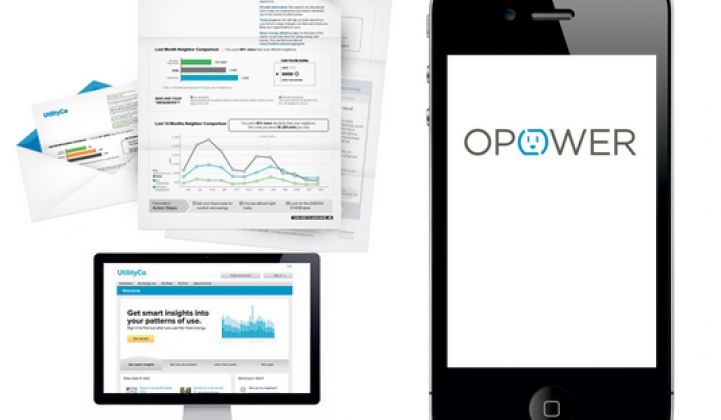Opower is undergoing a major evolution in its business model that may take it well beyond efficiency and into the management of distributed energy systems in utility territories.
With the release of its fifth-generation software today, that seems to be where Opower is headed. And it's just one of many offerings the Virginia-based company sees in its future.
"We're having conversations with lots of utilities about how they can play in distributed generation," said Dan Yates, Opower's co-founder and CEO in an interview. "This is rippling across the country, and we don't think it's fair to cut utilities out from saving themselves against the competition."
Yates wasn't ready to be specific about what that might look like, but he said it was part of a "multi-year evolution" that has moved the company into deep customer analytics, smart thermostat integration and residential demand response. With Opower analyzing 100 billion meter reads a year (and counting), one can imagine the value that that information would have for utilities interested in targeting distributed generation opportunities, electric vehicle integration or battery storage.
"It's all the same stuff" in terms of data management and behavioral science, said Yates.
Opower has succeeded in large part because it is a helpful ally to utilities that are required to encourage efficiency. By analyzing utility metering data, the firm sends out messages to consumers through mail, email, text or the web about how they stack against their neighbors. The approach, based on simple behavioral science, has proven remarkably effective for getting consistent residential savings in the 2 percent to 4 percent range -- enough to keep the regulators happy and show that utilities are doing something innovative.
But that part of the company's history is old news.
As Opower has expanded to 93 utilities and crunched data on more than 32 million consumers, its cloud-based software is becoming deeply embedded into utility customer care and electronic billing operations. The result is a company that no longer just does behavioral analytics, said Yates.
"We’ve outgrown our moniker. We are an enterprise customer engagement platform," he said.
Chalk up Opower as the latest intelligent efficiency company in recent months to declare its original description outdated -- joining the ranks of companies like EnerNOC, FirstFuel and Nest that are in the process of rebranding.
The Opower 5 platform is part of that evolution, said Yates. In 2012, the company was getting so many requests from utilities for customization and deeper ways to categorize customers that it couldn't keep up. So over the last eighteen months, Opower has re-architected a new brand new portal based on Apache Hadoop that can handle billions of data points every minute.
The system also utilizes Elasticsearch, a big-data search engine that can instantaneously sort a utility's customers based on location, income, engagement, energy usage and a host of other categories. And along with having customized data on the back end, the utility can also customize the web portal in virtually any way it wants.
"The idea is to give the utility a visual segmentation and provide granular business intelligence," said Yates. "They now have new ways to look at customer data, and we can offer 21st-century marketing."
As Opower moves deeper into residential demand response and smart thermostat integration, it has also added new tools for utilities to manage those programs.
Over the summer, Opower partnered with the Baltimore utility BGE to test out its behavioral demand response program. With simple customized emails and text messages, Opower was able to lower residential demand by 5 percent during peak times. The company said a nationwide rollout could reduce the per-kilowatt cost of demand response by 40 percent.
BGE has expanded the program from 300,000 homes to 1.1 million this year, and Yates said that five new partnerships with utilities could be announced soon. Rather than requiring utilities to invest upfront in switching equipment that may or may not be used during peak times, Opower sees itself as an "insurance provider" that can deploy at low cost when needed just through behavioral cues.
On the smart thermostat side, Opower hasn't had many major updates since partnering with Honeywell in 2012. But Yates said that more functionality will be coming soon now that Honeywell has relaunched its smart thermostat.
All of this new functionality comes as Opower prepares to go public and prove to investors that it can grow well beyond its roots to stay competitive.
It certainly puts Opower in a unique position. While there are plenty of other companies trying to get in the home -- telecoms, security firms and smart equipment producers -- none of them have quite carved out the same relationship with utilities.
Nest and Opower are often pitted against one another as their offerings start to converge. But the company with the closest approach in the residential space may actually be Tendril, which, after a very troublesome shakeout 2012, is repositioning itself to be a "software-centric energy service management" company for utilities. Time will tell if competitors like Tendril can match Opower's steady pace of new offerings and customers.
A lot has changed for Opower over the years. And if the firm can find ways to make data from solar generation, electric vehicles and other distributed energy technologies even more useful to utilities, we could see yet more substantive change.
"We are a much different company today than we were five years ago," said Yates.



